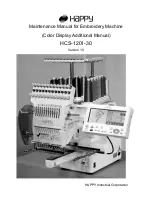
21
[1.0]
[2.2]
[5.0]
③
④
⑤
Altering the Stitch Length
Press the cursor buttons to move the cursor
①
under the stitch length value “2.2”
②
(default setting).
Press the button to decrease stitch length.
Press the button to increase stitch length.
The stitch length can be varied from 0.0 to 5.0.
①
Cursor
②
Stitch length (2.2)
NOTE:
Reverse stitch length cannot be set longer than 4.0.
②
②
①
①
Altering the Needle Drop Position
The needle drop position can be adjusted for straight
stitch patterns,
100-stitch model:
20-stitch model:
Press the cursor buttons to move the cursor
①
under the stitch width value “3.5”
②
(default setting).
Press the button to move the needle to the left
③
.
Press the button to move the needle to the right
⑤
.
①
Cursor
②
Stitch width (3.5)
③
Left (0.0)
④
Middle (3.5)
⑤
Right (7.0)
00 01 02 03 04 05 06 07 08 09
10 11 12 13 14 15 16 17 18 19
20 21 22 23 24 25 26 27 28 29
30 31 32 33 34 35 36 37 38 39 40 41 42 43
F
F F F F F F A F F F F A F
F F F F F F F F F F F F F F
F F F F F F F F F F F F F F
F F F F F F F F F F F F F F
F F F F F F F F F F F F F F
60 61 62 63 64 65 66 67 68 69 70 71
58 59
44
50 51 52 53 54 55 56 57
45 46 47 48 49
90 91 92 93 94 95 96 97 98 99
86 87 88 89
72 73 74
70 81 82 83 84 85
75 76 77 78 79
00 01 02 03 04 05 06 07 08 09
10 11 12 13 14 15 16 17 18 19
20 21 22 23 24 25 26 27 28 29
30 31 32 33 34 35 36 37 38 39 40 41 42 43
F
F F F F F F A F F F F A F
F F F F F F F F F F F F F F
F F F F F F F F F F F F F F
F F F F F F F F F F F F F F
F F F F F F F F F F F F F F
60 61 62 63 64 65 66 67 68 69 70 71
58 59
44
50 51 52 53 54 55 56 57
45 46 47 48 49
90 91 92 93 94 95 96 97 98 99
86 87 88 89
72 73 74
70 81 82 83 84 85
75 76 77 78 79
10 11 12 13 14 15 16 17 18 19
00 01 02 03 04 05 06 07 08 09
A
A
A
A
A
A
A
A
A
A
















































